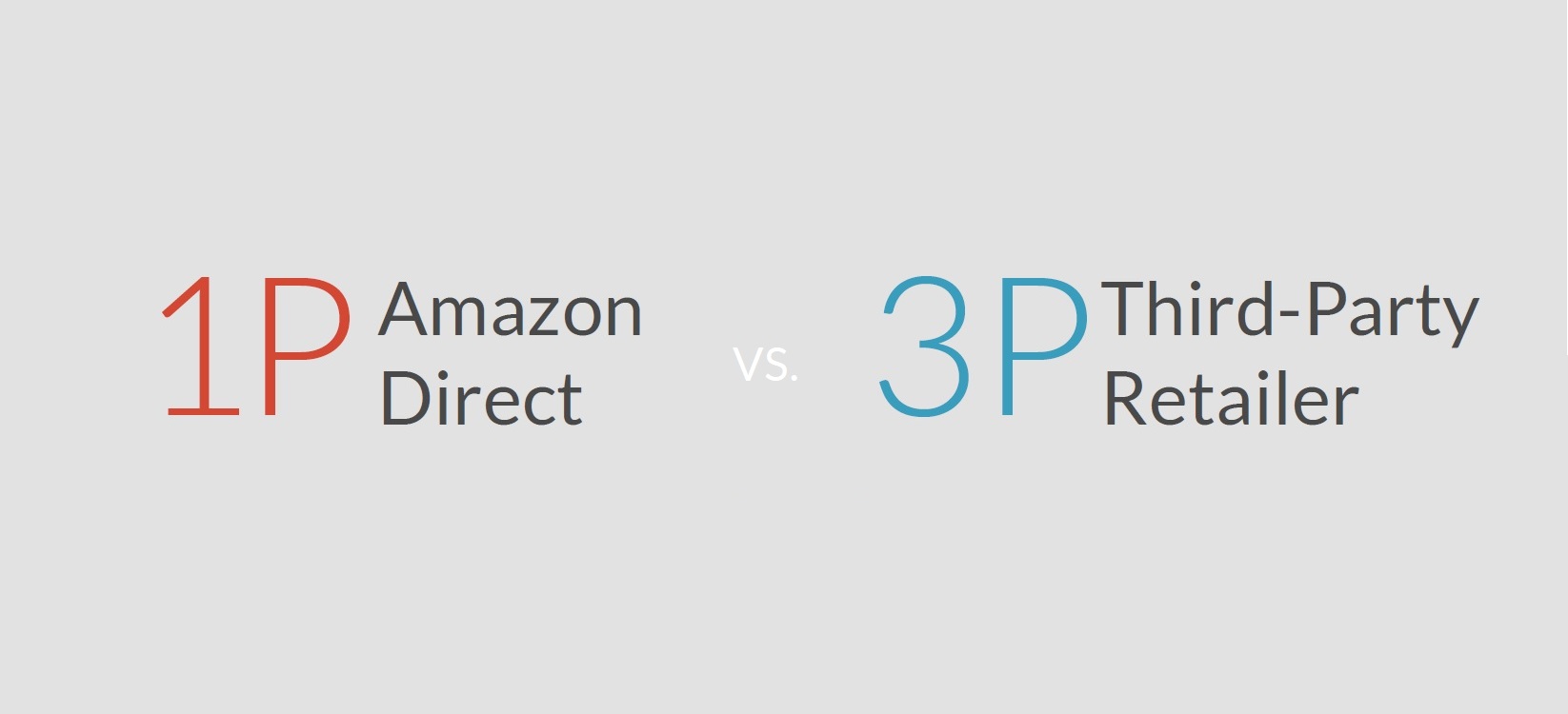Typically, you have two options: 1p (Vendor Central) and 3p (Seller Central). Choosing between these two options depends on a number of factors and relies mostly on your unique needs, capabilities, and preferences.
Consider your business processes and activities. Do you sell your products to other retailers? Or do you take a Direct to Consumer (DTC) approach? Just as well, one strategy that has been successful in the past may not be ideal for your business now. To make the right decision, dig into our guide to choosing between 1p and 3p.
Consider the following factors when choosing between an Amazon 1p or 3p supply strategy.
The Differences Between 1p and 3p
To make a more informed decision, it helps it understand exactly what both of these strategies do.
1p
By opting for 1p, Amazon will essentially be your retailer and your brand will be the wholesale supplier to Amazon. To qualify for 1p, you will need to have an invitation from Amazon. Once approved, you’ll then be sent a purchase order. It will be your responsibility to fill this purchase order and ship the products to Amazon. Once this is complete, Amazon will then have ownership of your product and they will control the pricing of your product.
The platform will also have the right to charge your brand fees for things like advertising, merchandising, and chargebacks. Each item or ASIN sold under the 1p strategy will boast a “Ships from and sold by Amazon.com” note on the product page. Those who opt for this model will operate under Vendor Central. This handy dashboard lets you look into things like your purchase orders, analytic insights into advertising, and different reporting features.
The Pros of 1p
- You can use Vendor Central to examine the status of your purchase orders, merchandising efforts, etc.
- Your products will feature a “Ships from and sold by Amazon.com” note that is substantially more attractive to shoppers who trust in the speedy shipping process Amazon offers.
- You won’t have to deal with shipping processes, other than your purchase orders. Since these are sent in bulk as a wholesaler, your time spent dealing with shipping processes is minimal.
The Cons of 3p
- Amazon will own your products.
- Amazon will control your product pricing, which results in price matching and lower product pricing
- Amazon can charge you hidden fees for things like merchandise and advertising allowances as well as chargebacks.
3p
The 3p model differs from the 1p model in that you are established as the retailer, while Amazon is simply the platform you sell your product on. The 3p approach is a Direct to Consumer approach. Instead of Vendor Central, you’ll have access to Seller Central. This dashboard offers many of the same tools and benefits that Vendor Central does, but you’ll be able to use it to sell products directly to your customers. You can also use Seller Central to draft and publish your own product pages, as well as check your order statuses and monitor your inventory. This model also allows brands to gain control over their products and remain the sole owner.
You also have full control over your pricing, which is not possible under the 1p model. You have the choice of Fulfillment by Amazon (FBA), Fulfillment by Merchant (FBM), or Seller Fulfilled Prime (SFP.) If you choose the first option, Amazon will handle the shipping process. In general, you have more control over your products with a 3p approach, though this can be a downside if your business is a wholesale manufacturer.
The Pros of 3p
- You have full authority over your pricing.
- You can adjust your pricing as-needed to stay above the competition.

You’ll have more control over your brand, listings, promos, and the volume of product you wish to launch.
The Cons of 3p
- You’ll need a lot of bandwidth, even if you’re opting for FBA or FBM.
- You’ll be responsible for your listing and storefront creation, which can be tedious and difficult to manage.
- You will be responsible for all advertising and marketing choices, which can cut a chunk out of your budget and may be unsuccessful.
Capabilities
Look at the strengths of your business realistically. If your brand has some substantial and successful DTC sales, then taking the 3p route may be more ideal for your brand’s capabilities, rather than a more “retail” scenario. Just as well, if you are a relatively traditional brand that works in retail, you might want to look into 1p. This is especially so if you have excellent shipping and logistical processes in place and don’t use FBA (Fulfilled by Amazon) to deliver your products.
If you want to shift to something different, consider your operations carefully. If your plan is to scale your business on Amazon significantly (which is an excellent idea!) then you will also need to think about how your operations will handle a significant volume increase. Namely, you’ll need to think about how well your business can scale quickly. You do have the option of opting for FBA, whether you’re a 1p vendor or 3p seller. This can offer some significant flexibility when it comes to shipping and inventory. However, it’s also worth considering how an in-house operational scenario could benefit your brand.
Products Across Channels
The biggest difference between 1p and 3p is the way that Amazon will tackle the pricing of your products. With 1p, the platform will engage in price matching, which will affect your products across a number of different channels. If you have a channel in place that isn’t MAP compliant, which is common for brands, then Amazon will likely price match your products or even sell below. With a 3p seller approach, you’ll have full control over your retail pricing, though there are a few small exceptions. Opting for a 3p approach could help your brand deal with significantly fewer channel pain points.
Profitability
Ask yourself: “What makes my brand the most profitable on the Amazon platform?” Outside of capabilities and channel conditions, you will also need to consider profitability. Your brand’s profitability will depend on quite a few different factors, as all businesses do on and off Amazon. 1p or 3p may not always be the most profitable for every brand out there. To make the right choice, consider your average selling price or ASP. You should also consider your inventory volume and each of your products’ weight and dimensions as well. We recommend running a profit analysis before choosing a 1p or 3p strategy.
Revenue
Revenue is obviously a big part of selling anywhere online. Most brands will focus on opting for a supply method that will help them max out their sales, which makes sense. In the past, choosing between 1p or 3p would impact your business significantly in terms of revenue, as Amazon offered very different programs for each supply method.
However, things have changed a bit on the platform in the last few years. Now, Amazon removed many of those programs and instead focused on creating minimal and effective programs instead. Some programs are definitely easier to use than others. However, businesses are able to use content, sponsored listings, SEO, advertising, promos, and other marketing programs the same way across 1p and 3p strategies. This is quite nice, as you can focus more on your capabilities and profitability.
Hybrid Strategy
A hybrid strategy may be a good idea for some brands. However, it isn’t ideal for everyone. Despite the idea that it’s the best of both scenarios, a hybrid 1p and 3p approach could add a lot of unneeded and unnecessary complications to your business. Some conflicting elements of 1p and 3p can turn into serious roadblocks instead of actionable solutions if your business is not suited for this option. Many hybrid brands will only tack on a second supply method after their business has been successfully established with one supply method.
If your profitability needs and channel pain points call for a secondary supply method, then it could be worth the investment. In the end, your best bet is to not oversimplify the decision you make. Really focus on your brand’s capabilities, channel requirements, and overall profitability. Try not to focus too much on revenue when choosing a supply method. Only look into a hybrid option if your genuinely have good reason to and can handle the additional complexities. How was our guide to choosing between 1p and 3p? Tell us which method for supply you’ve chosen and why in the comments section below.
